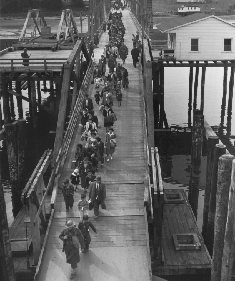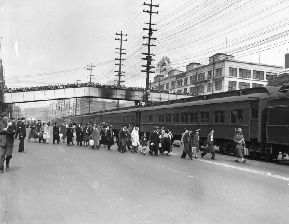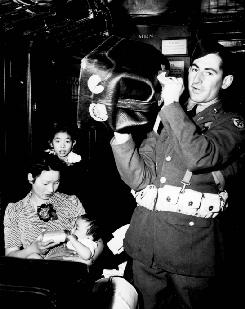|
Military Police posting Civilian Exclusion Order No. 1, requiring evacuation of Japanese living on Bainbridge Island, in Puget Sound, Washington. Photograph in Final report, Japanese evacuation from the West coast, 1942. Washington D.C.: U.S. Government Printing Office, 1943, pg. 435.
|

|
|
Instructions to All Japanese Living in Bainbridge Island. In American concentration camps: a documentary history of the relocation and incarceration of Japanese Americans, 1942-1945. New York: Garland, 1989.
|
Provisions have been made to give temporary residence in a reception center elsewhere. Evacuees who do not go to an approved destination of their own choice, but who go to a reception center under Government supervision, must carry with them the following property, not exceeding that which can be carried by the family or individual:
- Blankets and linens for each member of the family;
- Toilet articles for each member of the family;
- Clothing for each member of the family;
- Sufficient knives, forks, spoons, plates, bowls, and cups for each member of the family;
- All items carried will be securely packaged, tied, and plainly marked with the name of the owner and numbered in accordance with instructions received at the Civil Control Office;
- No contraband items may be carried.
|
|
“Not Time Enough.” Editorial, Bainbridge Review, March 26, 1942, pg. 1.
|
But we are talking here about 191 AMERICAN CITIZENS! Where, in the face of their fine record since December 7, in the face of their rights of citizenship, in the face of their own relatives being drafted and enlisting in our Army, in the face of American decency, is there any excuse for this high-handed, much-too-short evacuation order?
|
|
“Bainbridge Japanese Wistful and Willing, Aliens Register to Leave Island Monday.” Seattle Times, March 25, 1942, pg. 10.
|
Bainbridge Island Japanese, ordered evacuated from the island by next Monday, went willingly but wistfully today to the evacuation center established at the old Winslow dock to register for removal.
There were aged Japanese, not citizens of this nation; members of a younger generation, who where born in this country and are citizens and younger persons, some as young as 4 years old, who congregated at the registration center.
There was no apparent antagonism to the evacuation order. The aliens and the American-born seemed resigned to the fact that the Army had deemed it necessary for all persons of Japanese blood be removed from the island.
|
|
“Tears, Smiles Mingle as Japs Bid Bainbridge Farewell.” Seattle Times, March 30, 1942, pg. 1.
|
There was a great gathering of white friends at Eagledale before the evacuation was completed. These friends, as well as soldiers, gave the departing Japanese every help.
It was a pathetic exodus.
There were mothers with babies in arms, aged patriarchs with faltering steps, high school boys and girls, and some children, too young to realize the full import of the occasion. The youngsters frolicked about, treating the evacuation as a happy excursion.
|
|
Japanese Evacuation Report #7. Written by Joseph Conard of the Seattle Office of the American Friends Service Committee dated March 26, 1942. Joseph Conard, Collector, Box 4. Hoover Institution Archives.
(See full report)
|
While the Japanese families were registering yesterday, the soldiers often looked after the little children and proved to be pretty good nurse maids. I shall always remember the picture I saw of a soldier encumbered by his bayonet bending down to pick up a little Japanese girl, no bigger than a doll, and the little girl and the soldier beaming merrily at each other all the while.
|
|
Seattle Post-Intelligencer Collection. Museum of History and Industry, Seattle. Washington. PI-28053. Bainbridge Island evacuees boarding ferry under army guard.
|

|
|
“Evacuees Sing on Trip.” Bainbridge Review, April 2, 1942, pg. 1.
|
The Navy and others who feared the presence here of Japanese aliens and Japanese-American citizens breathed easier this week, for the Island was cleared of every last one of its 274 Japanese residents in the nation’s first enforced evacuation.
There were others, though, who mourned at their departure. They included Caucasians who gathered at the Eagledale dock Monday morning and wept unashamed as their Japanese neighbors obediently boarded the ferry Keholoken for their last ride from the Island for a long time, a ride which was the first step in the government’s forced evacuation of them to the reception center at Camp Manzanar, high in Owen Valley, California.
The Japanese, themselves, remained outwardly calm for the most part. None created any disturbance, although some wept when the actual moment came for boarding the ferry. For many days previously, the Japanese made “good-bye” calls on their Caucasian friends. Especially tearful were the parting scenes at Bainbridge High School where friends of many years were forced to part.
|
|
Seattle Post-Intelligencer Collection. Museum of History and Industry, Seattle, Washington. PI-28058. Bainbridge Island evacuees walking to train, watched by crowd on overpass.
|
 _ _
|
|
Japanese Evacuation Report #5. Written by Joseph Conard of the Seattle Office of the American Friends Service Committee dated April 2, 1942. Joseph Conard, Collector, Box 3, Notebook, April 1942. Hoover Institution Archives.
|
The part played by the Army in the evacuation of the Bainbridge Island Japanese was splendid, the epitome of thoughtful planning and friendly efficiency. Friendly soldiers drove army trucks around the Island and picked up the Japanese families and brought them to the ferry. The ferry left exactly on time, and on the way over to Seattle the Japanese were divided into groups and when the ferry docked each group walked briskly to the Pullman car to which it was assigned. Pullman porters were on hand and helped old ladies board the train, each person was given $2.00 a day to spend in the diner for food, and to each group a soldier was assigned who looked like Mother Carey as he counted his flock to see to it that none, old or young, got lost.
|
|
Photograph by Tacoma News Tribune photographer, Howard Clifford. UW11318, Special Collections and Preservation Division, University of Washington Libraries.
|
 _ _
|
|
We’ll Tell Sometime.” Editorial, Bainbridge Review, April 2, 1942. Pg. 4.
|
We wish we could give you the name of the officer who best summed up their attitude, but we can’t. Here, at least, is what he said:
“Why these people (the Island Japanese) have completely won us over. Do you know what they did the first day we arrived? They sent four or five of their young people down to help us get acquainted with the Island. They actually helped our men post the evacuation notices. Having to move these people is one of the toughest things this outfit has ever been told to do.”
|
|
“Courtesies Told of” Letter. Japanese American Courier, April 3, 1942. Pg. 4.
|
Dear Mr. Sakamoto:
It has been a long time since I last contacted you and I imagine you are very busy at present.
The whole population of Bainbridge Island left our sweet home of many years and now are on our way to Owens Valley. I would like you to convey the content of this note to the rest of the Japanese in Seattle.
When I left the Island I was a bit worried about our treatment, but when we sat down to eat our lunch on the train, I could not hide the tears of appreciation. Food, service of soldiers, and the special attention they gave to the children, the attention we received from the porters and soldiers at bed-time–we were treated like first-class passengers.
I do not know how others feel, but as for myself and my family of seven, our hearts are filled with the deepest appreciation.
At present we are passing through California prairies, and drawing a mental image of Owens Valley.
When we reach our destination, I will write to you again. Please take good care of yourself.
From the train
Sukezo Takayoshi.
March 31, 1942
|
|
Report of Service and Control Station, Bainbridge Island Japanese Evacuation. Written by Tom G. Rathbone, Field Supervisor. General Correspondence of the Secretary of War; Assistant Secretary of War; General DeWitt; WCD and various Army Commands. Papers of the U.S. Commission on Wartime Relocation and Internment of Civilians. Part 1, Numerical file archive. Reel 2 [894].
|
The actual evacuation took place Monday morning, March 30, at 11:00 a.m. All agencies mentioned had cooperated with the Army in developing the necessary plans and in the securing of the necessary transportation facilities from the Island to the mainland. Trucks were secured to transport the Japanese from their homes to the ferry dock, and assistance of army personnel was secured to handle baggage which the Japanese were allowed to take with them. The move was carried out with precision and orderliness, and there were no incidents of any description detrimental to the interests of the evacuees. The actual leave-taking between friends of long standing was a sad occasion, and everyone involved tried to cooperate understandingly in every way possible. The ferry left the Island at 11:20, and upon arrival in Seattle the Army cleared the immediate area around the train and the Japanese were escorted to the train immediately. The whole process was orderly and very well handled. The Army authorities, in particular Lieutenant-Colonel Malone and Major Bisenius, are entitled to commendation for their very fine administration of their portion of the evacuation program. The train was quickly loaded and left Seattle at 12:40.
|



